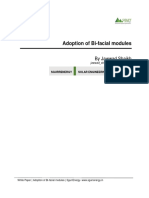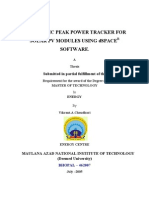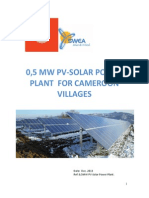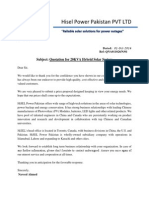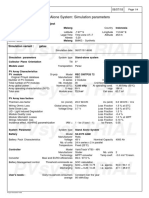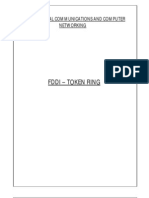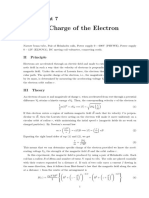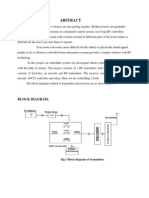Professional Documents
Culture Documents
Solar Panel Cleaning Robot
Copyright
Available Formats
Share this document
Did you find this document useful?
Is this content inappropriate?
Report this DocumentCopyright:
Available Formats
Solar Panel Cleaning Robot
Copyright:
Available Formats
Volume 3, Issue 3, March– 2018 International Journal of Innovative Science and Research Technology
ISSN No:-2456-2165
Solar Panel Cleaning Robot
Babu K, Dinesh kumar P, Kamala priya S, Kathirvel P
1,2,3UG Students, Department of Instrumentation and Control Engineering, INDIA
4Assistant Professor of Department of Instrumentation and Control Engineering Dr. Mahalingam College of Engineering and
Technology, Pollachi, INDIA
Abstract:- The dust particles accumulating on the solar The cleaning of dust particles on the solar panel is a
panels will prevent the solar energy from reaching the huge problem because it’s time consuming process and
solar cells, thereby reducing the overall power requires lot of man power and money. To remove this
generation. Power output is reduced as much as by 50%, limitation, robotics can be used as it eliminates human
if the module is not cleaned for a month. In order to labour and at the same time more economical and
regularly clean the dust, an automatic cleaning system autonomous.
which removes the dust on the solar panel is developed.
In this paper, the problem is reviewed and the method
for dust removal is discussed. A robot cleaning device is
developed and it travels the entire length of the panel. A
PIC microcontroller is used to implement robots control
system. The robot provided a favourable result and
proved that such a system is viable by making the
robotic cleaning possible, thus helping the solar panel to
maintain its efficiency.
Keywords:- PV panels, Brush, DC motors, microcontroller,
battery, Dust effects.
Fig.1:- solar panel
I. INTRODUCTION II. ANALYSIS OF DUST ON PANEL
After the invention of the solar cell, the solar The accumulation of dust on the surface of a
technology reached the skies by implementing solar panels photovoltaic module, decreases the radiation reaching the
that use the solar energy to generate electrical energy. solar cell and causes loss in the generated voltage and
Renewable energy is used in all the industries and they use power. Dust doesn’t only reduce radiation on the solar cell,
huge solar panels in more numbers in the form of an array. but also changes the dependence on the angle of incidence
On the other hand it has also started playing a major role in of such radiation. According to research, daily energy loss
the household usage. Now the problem with the along a year caused by dust deposited on the surface of the
implementation of solar panels is, their maintenance. PV module is around 4.4%. During long periods without
Different cleaning methods are used to clean the solar panels rain, daily energy loss can be higher than 20%. In addition,
to maintain their efficiency [1]. After one year of exposure the irradiance loss is not constant throughout the day and is
without cleaning, the systems were cleaned using strongly dependent on the sunlight incident angle and the
pressurized distilled water spray with brushing for one of the ratio between diffuse and direct radiations. When studied as
plant that showed 6.9% energy generation efficiency a function of solar time, the irradiance loss is symmetric
[2].There are many factors that affect PV panel’s power with respect to noon, where they reach the minimum value.
efficiency, such as, shadow, snow, high temperatures,
pollen, bird droppings, sea salt, dust and dirt. The main PV module performance has been tested under the
factor that affects a PV panel’s efficiency is dust, which can deposition of different pollutants (red soil, ash, sand,
reduce its efficiency by up to 50%, depending on the calcium carbonate and silica). According to the obtained
environment. results, a drop of PV module’s voltage and output power is
observed when dust particles are deposited on the PV
Cleaning dirty panels with commercial detergents module depending on the mass accumulated and the type of
can be time consuming, costly, hazardous to the pollutant. Moreover, larger reduction occurs when the PV
environment or even corrode the solar panel’s frame. module’s temperature is increased. In addition to that,
Ideally, solar panels should be cleaned every few weeks to keeping the PV modules clean and cool, results inefficient
maintain peak efficiency, which is especially hard to do for system performance. Power generation in the solar panel
large solar panel arrays. There is a need for an automated with dust and without dust with varying load resistance is
cleaning solution to this problem which can service large experimentally determined. [4]
ground based solar array up to an operating park of 22,000
panels (20,000 Square meters).
IJISRT18MA169 www.ijisrt.com 196
Volume 3, Issue 3, March– 2018 International Journal of Innovative Science and Research Technology
ISSN No:-2456-2165
III. NEED FOR AN AUTOMATIC PANEL CLEANER returns back to the carrier robot. The carrier robot moves to
the next panel and the process is continued.
Accumulation of dust on even one panel, reduces
their efficiency in energy generation. That is why; the B. Carrier Robot
panel’s surface should be kept as clean as possible. Current
human based cleaning methods for Solar panels are costly in The carrier robot detects the solar panel with the
terms of time, water and energy usage. No automation has help of IR sensor and stops when the sensor output becomes
taken place in cleaning the solar panels, so, there exists a high. The sensors are used to sense the start and end of
need for developing automatic cleaning machines which can panels. It helps the robot to understand where to stop and
clean and move easily on the glass surface of the panels. where to start. When the carrier robot detects the panel, the
output of the IR sensor becomes high and it stops the
movement of the carrier robot. At this time, the transmitter
IV. PV EFFICIENCY sends the signal to the cleaning robot to perform its cleaning
action.
Efficiency in photovoltaic solar panels is measured by The movement of the carrier robot is performed
the ability of a panel to convert sunlight into usable energy by the driver circuit. After cleaning the panel, the cleaning
for human utility. Maximum efficiency= {(max power robot reaches the carrier robot and transmits the signal to the
output)/(incident radiation flux*area of collector)}*100. carrier robot. As soon as the carrier robot receives the signal,
the carrier robot along with the cleaning robot travels to the
V. METHODOLOGY next panel and the process is continued. The transmitter and
the receiver action actions are carried out by means of the
The proposed solar panel cleaning robot is used to transmitter and the receiver module.
remove the dirt and dust deposited on the solar panel thus
helping the solar panel to absorb the maximum quantity of Block Diagram
energy.
The proposed system consists of two main parts, IR PIC TX/RX
the first is the cleaning robot and the second is the carrier SENSOR MODULE
robot. The carrier robot acts as a carrier that carries a
cleaning robot by moving from one panel to another. The
cleaning robot travels along with the carrier robot, covering
the entire length of the panel. The brush which is attached to DRIVER DC
the cleaning robot takes away the dirt and dust from the CIRCUIT MOTOR
panel. The robot is programmed with a microcontroller
which controls its operations and its movement from one Fig. 2:- Block Diagram
panel to the other panel. C. Cleaning Robot
The main criterion of the cleaning system design When the carrier robot stops its movement by
is its ability to clean multiple panels in a solar farm using a detecting the panel, it transmits the signal to the cleaning
single robot. Such a system is considerably much simpler robot. The cleaning robot, after receiving the signal from the
than having multiple robots in the same farm working carrier robot, travels to the entire length of the panel in
simultaneously. forward directions.
On moving in forward direction, the cleaning robot
In practice, cleaning of solar panels should be removes the dust and dirt accumulated in the panel with a
frequently done which makes the process more laborious brush which is attached to it. After reaching the time
and expensive [5].In this paper, the effects of accumulated duration, it travels in reverse direction and reaches the
dust on the performance of the solar panels are investigated carrier robot. On reaching the carrier robot, it again
by referring the results obtained by experimentation in dusty transmits the signal to the carrier robot. The carrier robot
atmosphere of different levels [3]. An auto cleaning robot to after receiving the signal, starts to move and when it senses
work as the auto cleaner which is equipped on the solar the panel, it stops again and the process is continued.
panel is also proposed.
DRIVER PIC TX/RX
A. Working Principle CIRCUIT MODULE
EE
The carrier robot, along with the cleaning robot DC
moves towards the solar panel and stops its movement by DRIVER DC
MOTOR
sensing the solar panel. The carrier robot then sends the CIRCUIT MOTOR
signal to the cleaning robot. By receiving the signal, the
cleaning robot travels to the entire length of the solar panel
in both forward and backward directions and cleans the BRUSH
panel for the specified time duration. After cleaning, it
Fig. 3:- Cleaning Robot Block Diagram
IJISRT18MA169 www.ijisrt.com 197
Volume 3, Issue 3, March– 2018 International Journal of Innovative Science and Research Technology
ISSN No:-2456-2165
D. RF Module – Transmitter & Receiver Receiver Block Diagram
The RF modules are 433 MHz RF transmitter and
receiver modules [7][10]. The transmitter draws no power
when transmitting logic zero while fully suppressing the
carrier’s frequency. It thus consumes significantly low
power in battery operation. When logic one is sent, carrier is
fully on 4.5mA with a 3volts power supply[9]. The data is
sent serially from the transmitter which is received by the
tuned receiver. Transmitter and the receiver are duly
interfaced to two microcontrollers for data transfer [8]
Transmitter Block Diagram
Fig. 6:- Receiver Block Diagram
Circuit Diagram
Fig. 4:- Transmitter Block Diagram
Circuit Diagram
Fig. 7:- ReceiverCircuit Diagram
Flow Chart
Fig. 5:- Transmitter Circuit Diagram
Fig. 8:- Flow Chart
IJISRT18MA169 www.ijisrt.com 198
Volume 3, Issue 3, March– 2018 International Journal of Innovative Science and Research Technology
ISSN No:-2456-2165
Performance of PVPanels”
VI. CONCLUSION http://docseurope.electrocomponents.com/webdocs/003
0/0900766b80030030.pdf.
This project highlights the effect of dust, dirt, [5]. Ravi Tejwani, Chetan S Solanki. “360° Sun Tracking
pollen, sea salt, and bird droppings on the PV systems’ with Automated Cleaning System for PV” Department
efficiency. Dust has a major impact on the efficiency and of Energy Science andEngineering, Indian Institute of
performance of the solar panels. The reduction in the peak Technology Bombay.
power generation can be up to 10 to 30%. Power reduction [6]. http://users.ece.utexas.edu/~valvano/Datasheets/L293d.
was observed due to dust accumulation on the panels and pdf
this can be improved by using robotic cleaning method. It [7]. www.ieee.org/explore.
has increased Power generation capacity of the solar panels. [8]. http://www.mikroe.com.
Easy maintenance, low cost and less power usage are few [9]. https://en.m.wikipedia.org.
advantages of this process. Finally, the reduction in the peak [10]. www.edgefvxkits.com.
power generation can also be overcome by using this
cleaning system.
The device is lightweight because most of its
material is made of aluminium. Comparing the costs of
cleaning by Manual operation and Automatic operation, the
cost for automatic cleaning is proved to be more economic
and significantly less cumbersome, particularly, in systems
with large number of solar panels. Frequent and periodical
cleaning ensures that the solar panels work consistently with
a good transmittance at all times [6].
VII. FUTURE SCOPE
The device that is developed, reduces the number
of workers needed to clean the arrays significantly. Further
development could be done to optimize the system to be
smaller, lighter and easier to assemble in higher volumes
and to become more user-friendly. The next focus will be on
diversifying the robot’s functionality by including auto-
inspection, communication and self-diagnostic features.
The installation of a thermal camera module that
will allow for inspection of the panels since the cleaning
head is in direct contact with every individual panel. Cold
spots just under the glass surface will indicate a section of
panel that remains un-cleaned and will prompt the cleaner to
make another pass if needed. Solar panel energy can be used
instead of using individual battery. Wireless cameras can be
also attached for perfect wireless operation.
REFERENCE
[1]. Qi zhang, xiao-long lu, jun-hui hu, “A solar panel
cleaning system based on a linear piezoelectric
actuator” Astronautics, Nanjing 210016, China, 25-27
Oct. 2013
[2]. S.A. Sulaiman, H.H. Hussain, N.S.H. Leh, and M.S.I.
Razali, Effects of Dust on the Performance of PV
Panels, World Academy of Science, Engineering and
Technology, 58, 588-593, 2011.
[3]. J.Zorrilla-Casanova, M. Piliougine, J. Carretero, P.
Bernaola, P. Carpena, L. Mora-Lopez, M. Sidrach-de-
Cardona. “Analysis of dust losses in photovoltaic
modules” world renewable Energy Congress
2011.Sweden, 8-13 May 2011.
[4]. Shaharin Anwar Sulaimana, Atul Kumar Singh,
MiorMaar of MiorMokhtara, Mohammed A. Bou-
Rabee, “Influence of Dirt Accumulation on
IJISRT18MA169 www.ijisrt.com 199
You might also like
- Component Description For Single Signal Acquisition and Actuation Module (SSAM) Control UnitDocument1 pageComponent Description For Single Signal Acquisition and Actuation Module (SSAM) Control UnitrudiNo ratings yet
- Inspection of Solar SystemsDocument155 pagesInspection of Solar SystemsDiptiman GuhaNo ratings yet
- Convert solar power to AC with a grid-connected inverterDocument12 pagesConvert solar power to AC with a grid-connected invertersalem BEN MOUSSANo ratings yet
- Solar CalculationsDocument12 pagesSolar Calculationshammad engineeringNo ratings yet
- Bifacial PV Modules - SgurrEnergyDocument12 pagesBifacial PV Modules - SgurrEnergySgurr EnergyNo ratings yet
- Solar PV Installer (Suryamitra) : Educate Your Mind in The Right DirectionDocument2 pagesSolar PV Installer (Suryamitra) : Educate Your Mind in The Right DirectiondaynongNo ratings yet
- Construction and Operation of Solar Farms CopDocument65 pagesConstruction and Operation of Solar Farms CoptammamshNo ratings yet
- Agenda: Cells and Components PV Performance PV Applications Codes and Standards Emergency ResponseDocument37 pagesAgenda: Cells and Components PV Performance PV Applications Codes and Standards Emergency Responsevivek_chavda4101No ratings yet
- Electrolytic ConductanceDocument8 pagesElectrolytic Conductancevijaye36100% (1)
- Solar Photovoltaic Systems Explained in 40 CharactersDocument57 pagesSolar Photovoltaic Systems Explained in 40 CharactersNag Y50% (2)
- Automatic Solar Panel Cleaning SystemDocument14 pagesAutomatic Solar Panel Cleaning SystemAdnan Shaukat50% (2)
- SR - No Specification Description of Items Unit Qty Rate AmountDocument4 pagesSR - No Specification Description of Items Unit Qty Rate AmountSayed Tehmeed AbbasNo ratings yet
- Solar Power Plant Project ProposalDocument29 pagesSolar Power Plant Project ProposalKhehracybercafe SahnewalNo ratings yet
- Proposal of Solar: PV System For: 19.80 KWDocument4 pagesProposal of Solar: PV System For: 19.80 KWGajju Gulsher BhaiNo ratings yet
- Solar Park GuidelinesDocument51 pagesSolar Park GuidelinesKamranNo ratings yet
- Automatic Solar Panel Cleaning System Increases EfficiencyDocument6 pagesAutomatic Solar Panel Cleaning System Increases EfficiencyFAH MANNo ratings yet
- Solar Panel Cleaning SystemDocument11 pagesSolar Panel Cleaning SystemAkshay Hejjaji67% (3)
- EPC BrochureDocument32 pagesEPC BrochureAmarinder Singh SandhuNo ratings yet
- Unit IV Wind and Solar Energy System 7thDocument12 pagesUnit IV Wind and Solar Energy System 7thmalik shafkatNo ratings yet
- Solar TrackingDocument98 pagesSolar TrackingPanati Sameera Lakshmi50% (4)
- Grid Tie Inverter MarketDocument8 pagesGrid Tie Inverter MarketSubhrasankha BhattacharjeeNo ratings yet
- SEDA Malaysia Grid-Connected PV Design Course ScheduleDocument3 pagesSEDA Malaysia Grid-Connected PV Design Course ScheduleKelly chatingNo ratings yet
- Solar Modules Cleaning GuidelinesDocument2 pagesSolar Modules Cleaning GuidelinesCNP WEBNo ratings yet
- Corporate BrochureDocument36 pagesCorporate BrochureEmmvee SolarNo ratings yet
- Solar Pat Checklist 111Document6 pagesSolar Pat Checklist 111Buddhisagar BastolaNo ratings yet
- SOLAR SIZING OPTIMIZATIONDocument40 pagesSOLAR SIZING OPTIMIZATIONscada enggNo ratings yet
- Solar Panel Cleaning Drone - ReportDocument49 pagesSolar Panel Cleaning Drone - ReportAtchayha P M100% (1)
- PLG Power Limited: Ref: PLG/RPPL/SPV-Plant/1 MW/2010 Date: 20 /july / 2010Document7 pagesPLG Power Limited: Ref: PLG/RPPL/SPV-Plant/1 MW/2010 Date: 20 /july / 2010fyuocuk8520No ratings yet
- Renewable Energy Scenario in India: A Generalised Overview..Document69 pagesRenewable Energy Scenario in India: A Generalised Overview..Ramdhan MeenaNo ratings yet
- Solar Project Report 2Document19 pagesSolar Project Report 2kamalakarvreddyNo ratings yet
- X-Ray Photoelectron Spectroscopy (XPS) : Electron Spectroscopy For Chemical Analysis (ESCA)Document24 pagesX-Ray Photoelectron Spectroscopy (XPS) : Electron Spectroscopy For Chemical Analysis (ESCA)Jatin DarveNo ratings yet
- 2023 PVEL PV Module Reliability Scorecard Executive SummaryDocument14 pages2023 PVEL PV Module Reliability Scorecard Executive SummaryWarren MorseNo ratings yet
- Building Integrated Solar Thermal CollecDocument20 pagesBuilding Integrated Solar Thermal CollecMenandros GeorgiouNo ratings yet
- BHEL Solar Solutions From Concept to CommissioningDocument5 pagesBHEL Solar Solutions From Concept to CommissioningRahulNo ratings yet
- 0.5MW PV Solar Plant CameroonDocument4 pages0.5MW PV Solar Plant CameroonMuhammad Asif ShafiqNo ratings yet
- Solar Combiner Box TrainingDocument33 pagesSolar Combiner Box TrainingRavi Teja100% (1)
- Solar Farm Diagramnov17 2014Document1 pageSolar Farm Diagramnov17 2014Sikumbang MobilNo ratings yet
- Bosch Solar Energy SolarstromDocument12 pagesBosch Solar Energy SolarstromAlper KoçerNo ratings yet
- SPPC-W4 - Part II - General Technical SpecificationsDocument65 pagesSPPC-W4 - Part II - General Technical SpecificationsrekzziNo ratings yet
- Solar Rooftop PresentationDocument50 pagesSolar Rooftop PresentationmichkohktNo ratings yet
- Solar Plan 10 KW-DR - Sudha PDFDocument7 pagesSolar Plan 10 KW-DR - Sudha PDFAravind PandianNo ratings yet
- Brochure PV-T enDocument2 pagesBrochure PV-T enDarko MarjanovicNo ratings yet
- TrinaPro Solution Guide BookDocument17 pagesTrinaPro Solution Guide BookNusrat JahanNo ratings yet
- Solar Training at ONGC, DehradhunDocument54 pagesSolar Training at ONGC, DehradhunParveen ChoudharyNo ratings yet
- Global Trends in Solar PV Technology R&D and CommercializationDocument35 pagesGlobal Trends in Solar PV Technology R&D and CommercializationSurya Pratap SinghNo ratings yet
- 20kva - Nav - Ua - 01102014 40 Amp FaisalabadDocument9 pages20kva - Nav - Ua - 01102014 40 Amp FaisalabadfibrefNo ratings yet
- Solar Panel Cleaning RobotDocument32 pagesSolar Panel Cleaning RobotChaymaa100% (1)
- EP SolarDocument45 pagesEP SolarMohd Farihan Bin Jamaludin100% (1)
- 0141 - 4kWp To 6kWp Solar Photovoltaic Power Plants - CREDADocument19 pages0141 - 4kWp To 6kWp Solar Photovoltaic Power Plants - CREDAPranavateja Chilukuri100% (1)
- PVSYST V6.73 Simulation of a Stand Alone System in Malang, IndonesiaDocument4 pagesPVSYST V6.73 Simulation of a Stand Alone System in Malang, IndonesiaEgavania ZerlindaNo ratings yet
- Monocrystalline and Polycrystalline Solar PanelsDocument2 pagesMonocrystalline and Polycrystalline Solar PanelsSasha MîrzaNo ratings yet
- 85 KW RequestDocument3 pages85 KW Requestاختر بلوچNo ratings yet
- Summer Industrial Training ReportDocument26 pagesSummer Industrial Training ReportAbhishek SinghNo ratings yet
- 4 Degradation FinalDocument26 pages4 Degradation Finalnedji hugaNo ratings yet
- Helioscope User ManualDocument38 pagesHelioscope User ManualbenignoNo ratings yet
- Solar Lighting System With Auto TrackingDocument62 pagesSolar Lighting System With Auto TrackingANAND KRISHNANNo ratings yet
- Design of A Mobile Phone Charging Station Utilizing PV Renewable Energy SystemDocument6 pagesDesign of A Mobile Phone Charging Station Utilizing PV Renewable Energy SystemMaria Blessie NavarreteNo ratings yet
- Solar PV System: Nurmuntaha Agung NugrahaDocument21 pagesSolar PV System: Nurmuntaha Agung NugrahaArdandy PrasetyoNo ratings yet
- Mechanism Design For Walking Typed Solar Panel-Cleaning Robot Using Triple Driving LinesDocument19 pagesMechanism Design For Walking Typed Solar Panel-Cleaning Robot Using Triple Driving LinesIAES International Journal of Robotics and AutomationNo ratings yet
- 6 Seminar Report - 07Document25 pages6 Seminar Report - 07vikasNo ratings yet
- Solar RoadwaysDocument23 pagesSolar RoadwaysMohammed rafeeqNo ratings yet
- EQ MAP SOlar Map 13th Edition-2020Document13 pagesEQ MAP SOlar Map 13th Edition-2020pbargotra786No ratings yet
- A Control Strategy For An Autonomous Robotic Vacuum Cleaner For Solar PanelsDocument13 pagesA Control Strategy For An Autonomous Robotic Vacuum Cleaner For Solar PanelsPaul Vincent LauretaNo ratings yet
- Development of solar panel cleaning robot using arduinoDocument6 pagesDevelopment of solar panel cleaning robot using arduinoEhsan AbarghueeNo ratings yet
- Automatic Power Factor ControllerDocument4 pagesAutomatic Power Factor ControllerInternational Journal of Innovative Science and Research TechnologyNo ratings yet
- Intelligent Engines: Revolutionizing Manufacturing and Supply Chains with AIDocument14 pagesIntelligent Engines: Revolutionizing Manufacturing and Supply Chains with AIInternational Journal of Innovative Science and Research TechnologyNo ratings yet
- Navigating Digitalization: AHP Insights for SMEs' Strategic TransformationDocument11 pagesNavigating Digitalization: AHP Insights for SMEs' Strategic TransformationInternational Journal of Innovative Science and Research TechnologyNo ratings yet
- A Review: Pink Eye Outbreak in IndiaDocument3 pagesA Review: Pink Eye Outbreak in IndiaInternational Journal of Innovative Science and Research TechnologyNo ratings yet
- Teachers' Perceptions about Distributed Leadership Practices in South Asia: A Case Study on Academic Activities in Government Colleges of BangladeshDocument7 pagesTeachers' Perceptions about Distributed Leadership Practices in South Asia: A Case Study on Academic Activities in Government Colleges of BangladeshInternational Journal of Innovative Science and Research TechnologyNo ratings yet
- Securing Document Exchange with Blockchain Technology: A New Paradigm for Information SharingDocument4 pagesSecuring Document Exchange with Blockchain Technology: A New Paradigm for Information SharingInternational Journal of Innovative Science and Research TechnologyNo ratings yet
- Mobile Distractions among Adolescents: Impact on Learning in the Aftermath of COVID-19 in IndiaDocument2 pagesMobile Distractions among Adolescents: Impact on Learning in the Aftermath of COVID-19 in IndiaInternational Journal of Innovative Science and Research TechnologyNo ratings yet
- Studying the Situation and Proposing Some Basic Solutions to Improve Psychological Harmony Between Managerial Staff and Students of Medical Universities in Hanoi AreaDocument5 pagesStudying the Situation and Proposing Some Basic Solutions to Improve Psychological Harmony Between Managerial Staff and Students of Medical Universities in Hanoi AreaInternational Journal of Innovative Science and Research TechnologyNo ratings yet
- Review of Biomechanics in Footwear Design and Development: An Exploration of Key Concepts and InnovationsDocument5 pagesReview of Biomechanics in Footwear Design and Development: An Exploration of Key Concepts and InnovationsInternational Journal of Innovative Science and Research TechnologyNo ratings yet
- Perceived Impact of Active Pedagogy in Medical Students' Learning at the Faculty of Medicine and Pharmacy of CasablancaDocument5 pagesPerceived Impact of Active Pedagogy in Medical Students' Learning at the Faculty of Medicine and Pharmacy of CasablancaInternational Journal of Innovative Science and Research TechnologyNo ratings yet
- Formation of New Technology in Automated Highway System in Peripheral HighwayDocument6 pagesFormation of New Technology in Automated Highway System in Peripheral HighwayInternational Journal of Innovative Science and Research TechnologyNo ratings yet
- Natural Peel-Off Mask Formulation and EvaluationDocument6 pagesNatural Peel-Off Mask Formulation and EvaluationInternational Journal of Innovative Science and Research TechnologyNo ratings yet
- Drug Dosage Control System Using Reinforcement LearningDocument8 pagesDrug Dosage Control System Using Reinforcement LearningInternational Journal of Innovative Science and Research TechnologyNo ratings yet
- The Effect of Time Variables as Predictors of Senior Secondary School Students' Mathematical Performance Department of Mathematics Education Freetown PolytechnicDocument7 pagesThe Effect of Time Variables as Predictors of Senior Secondary School Students' Mathematical Performance Department of Mathematics Education Freetown PolytechnicInternational Journal of Innovative Science and Research TechnologyNo ratings yet
- Enhancing the Strength of Concrete by Using Human Hairs as a FiberDocument3 pagesEnhancing the Strength of Concrete by Using Human Hairs as a FiberInternational Journal of Innovative Science and Research TechnologyNo ratings yet
- Supply Chain 5.0: A Comprehensive Literature Review on Implications, Applications and ChallengesDocument11 pagesSupply Chain 5.0: A Comprehensive Literature Review on Implications, Applications and ChallengesInternational Journal of Innovative Science and Research TechnologyNo ratings yet
- Advancing Opthalmic Diagnostics: U-Net for Retinal Blood Vessel SegmentationDocument8 pagesAdvancing Opthalmic Diagnostics: U-Net for Retinal Blood Vessel SegmentationInternational Journal of Innovative Science and Research TechnologyNo ratings yet
- The Making of Self-Disposing Contactless Motion-Activated Trash Bin Using Ultrasonic SensorsDocument7 pagesThe Making of Self-Disposing Contactless Motion-Activated Trash Bin Using Ultrasonic SensorsInternational Journal of Innovative Science and Research TechnologyNo ratings yet
- Placement Application for Department of Commerce with Computer Applications (Navigator)Document7 pagesPlacement Application for Department of Commerce with Computer Applications (Navigator)International Journal of Innovative Science and Research TechnologyNo ratings yet
- REDLINE– An Application on Blood ManagementDocument5 pagesREDLINE– An Application on Blood ManagementInternational Journal of Innovative Science and Research TechnologyNo ratings yet
- Beyond Shelters: A Gendered Approach to Disaster Preparedness and Resilience in Urban CentersDocument6 pagesBeyond Shelters: A Gendered Approach to Disaster Preparedness and Resilience in Urban CentersInternational Journal of Innovative Science and Research TechnologyNo ratings yet
- Exploring the Clinical Characteristics, Chromosomal Analysis, and Emotional and Social Considerations in Parents of Children with Down SyndromeDocument8 pagesExploring the Clinical Characteristics, Chromosomal Analysis, and Emotional and Social Considerations in Parents of Children with Down SyndromeInternational Journal of Innovative Science and Research TechnologyNo ratings yet
- Handling Disruptive Behaviors of Students in San Jose National High SchoolDocument5 pagesHandling Disruptive Behaviors of Students in San Jose National High SchoolInternational Journal of Innovative Science and Research TechnologyNo ratings yet
- Safety, Analgesic, and Anti-Inflammatory Effects of Aqueous and Methanolic Leaf Extracts of Hypericum revolutum subsp. kenienseDocument11 pagesSafety, Analgesic, and Anti-Inflammatory Effects of Aqueous and Methanolic Leaf Extracts of Hypericum revolutum subsp. kenienseInternational Journal of Innovative Science and Research TechnologyNo ratings yet
- A Curious Case of QuadriplegiaDocument4 pagesA Curious Case of QuadriplegiaInternational Journal of Innovative Science and Research TechnologyNo ratings yet
- A Knowledg Graph Model for e-GovernmentDocument5 pagesA Knowledg Graph Model for e-GovernmentInternational Journal of Innovative Science and Research TechnologyNo ratings yet
- Analysis of Financial Ratios that Relate to Market Value of Listed Companies that have Announced the Results of their Sustainable Stock Assessment, SET ESG Ratings 2023Document10 pagesAnalysis of Financial Ratios that Relate to Market Value of Listed Companies that have Announced the Results of their Sustainable Stock Assessment, SET ESG Ratings 2023International Journal of Innovative Science and Research TechnologyNo ratings yet
- Pdf to Voice by Using Deep LearningDocument5 pagesPdf to Voice by Using Deep LearningInternational Journal of Innovative Science and Research TechnologyNo ratings yet
- Adoption of International Public Sector Accounting Standards and Quality of Financial Reporting in National Government Agricultural Sector Entities, KenyaDocument12 pagesAdoption of International Public Sector Accounting Standards and Quality of Financial Reporting in National Government Agricultural Sector Entities, KenyaInternational Journal of Innovative Science and Research TechnologyNo ratings yet
- Fruit of the Pomegranate (Punica granatum) Plant: Nutrients, Phytochemical Composition and Antioxidant Activity of Fresh and Dried FruitsDocument6 pagesFruit of the Pomegranate (Punica granatum) Plant: Nutrients, Phytochemical Composition and Antioxidant Activity of Fresh and Dried FruitsInternational Journal of Innovative Science and Research TechnologyNo ratings yet
- Assignment FDDI TokenRingDocument6 pagesAssignment FDDI TokenRingkavindagayaNo ratings yet
- Kim Couthinho - Theon Couthinho - Neil Crasto - Frigen Dabre - Zelem DabreDocument19 pagesKim Couthinho - Theon Couthinho - Neil Crasto - Frigen Dabre - Zelem DabreSergiu MureșanNo ratings yet
- TGS 6 - Backpropagation-18.01.53.0065Document2 pagesTGS 6 - Backpropagation-18.01.53.0065Ki JahsehNo ratings yet
- ARM Cortex M3 RegistersDocument22 pagesARM Cortex M3 RegistersRaveendra Moodithaya100% (2)
- Exp10 ESC Electron Specific ChargeDocument4 pagesExp10 ESC Electron Specific ChargeUtkarsh AgarwalNo ratings yet
- Infrared people counter counts entriesDocument3 pagesInfrared people counter counts entriesthisissanjay100% (1)
- TriBand Trisector - SSC-760220020 - 2.2m AntennaDocument7 pagesTriBand Trisector - SSC-760220020 - 2.2m AntennaborisNo ratings yet
- Remote Telemetry For Industrial Gases - DPW900 - ANOVADocument5 pagesRemote Telemetry For Industrial Gases - DPW900 - ANOVAsunshine dream50% (2)
- Epson TM t82Document2 pagesEpson TM t82lalukurniawanNo ratings yet
- Automated Toll Gate System Using RFIDDocument5 pagesAutomated Toll Gate System Using RFIDKarthik DmNo ratings yet
- Installation Guide: HP Integrity rx4640 ServerDocument113 pagesInstallation Guide: HP Integrity rx4640 ServerbahmannewNo ratings yet
- Manual de Servicio de Equipo de Sonido de Radio mp3Document46 pagesManual de Servicio de Equipo de Sonido de Radio mp3daniel perezNo ratings yet
- Lab Report Process (Repaired)Document16 pagesLab Report Process (Repaired)amirulNo ratings yet
- Introduction To UT Flaw DetectorDocument26 pagesIntroduction To UT Flaw DetectorNail Widya Satya100% (1)
- Marshall Class 5 Owner ManualDocument4 pagesMarshall Class 5 Owner ManualJuan Cruz LeónNo ratings yet
- M.E. Electronics and Communication Engineering (Industry Integrated) BranchDocument49 pagesM.E. Electronics and Communication Engineering (Industry Integrated) BranchRagland CNo ratings yet
- Dna-Stp-Ai-U: General DescriptionDocument2 pagesDna-Stp-Ai-U: General DescriptionnpcopeNo ratings yet
- User Manual R11015 TLDocument80 pagesUser Manual R11015 TLJean Pierre Carranza CavaniNo ratings yet
- Manual FunctionBlock TersusDocument122 pagesManual FunctionBlock TersusFabiano Chaves SilvaNo ratings yet
- Analizador de Bateria Bc3000 Concorde Hart9Document13 pagesAnalizador de Bateria Bc3000 Concorde Hart9Roberto CayoNo ratings yet
- Digital clamp multimeter safety and operation guideDocument2 pagesDigital clamp multimeter safety and operation guideAgung DuemilanoveNo ratings yet
- Fig.1 Block Diagram of TransmitterDocument5 pagesFig.1 Block Diagram of TransmitterKranthi KumarNo ratings yet
- Short Overview of Perovskite Solar CellsDocument14 pagesShort Overview of Perovskite Solar CellsFAISAL TAIMURINo ratings yet
- Carvin Engineering Data: Receiving InspectionDocument4 pagesCarvin Engineering Data: Receiving InspectionBetoNo ratings yet
- Quick setup guide for D-Link ShareCenter DNS-320L cloud storageDocument5 pagesQuick setup guide for D-Link ShareCenter DNS-320L cloud storageMauricio GlezNo ratings yet
- Aircooled Liquid Chillers and Heat Pumps 47-178 kWDocument4 pagesAircooled Liquid Chillers and Heat Pumps 47-178 kWAnonymous KB3AksTpBNo ratings yet




